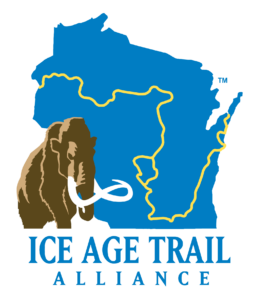Dedicated volunteers improved many acres of crucial habitat!

Dedicated Ice Age Trail volunteers helped improve crucial plant and wildlife habitats across three Ice Age Trail Alliance-owned preserves: SwampLovers (Dane County), Hartland Marsh (Waukesha County), and Steenbock (Columbia County). A total of 158 volunteers donated 2,136 service hours.
Winter, offering both challenging AND perfect conditions for the Habitat Improvement events, didn’t deter hardy sawyers, swampers, and brush haulers. Invasive trees and shrubs were removed from more than seven acres, allowing for the expansion of native prairie and oak savanna.

Table Bluff Segment, SwampLovers’ Preserve
January 19
A snowstorm canceled the originally scheduled event, but 9 volunteers came out a week later, donating 91 hours to clear invasive brush from oak savanna habitat. With almost two feet of snow, temperatures just above zero degrees, and steep topography, this hardy crew cleared nearly an acre of brush.
These efforts will help promote more native species, like oak trees, hazelnut shrubs, and Jacob’s ladder, to flourish!


Hartland Segment, Hartland Marsh Preserve
January 12 and 13
Warmer weather melted more than a foot of snow, allowing 79 volunteers to donate 1,042 hours and getting an incredible amount of work done. Volunteers cleared four acres of buckthorn from the oak woodlands on the Alliance-owned Hartland Marsh Preserve.
This work keeps the property’s mature oaks healthy, creates space for younger oak trees to grow, and allows native forbs like shooting stars and wild columbine to reestablish in the understory. Maintaining this habitat is critical for migrating and nesting birds, which depend on these large oak trees.


Gibraltar Rock Segment, Steenbock Preserve
February 9 and 10
Melted snow provided excellent conditions for removing invasive brush and trees. Donating 1,003 hours, 70 volunteers cleared 2.5 acres, helping restore the property’s remnant bluff prairie. Skilled sawyers demonstrated their felling skills, taking down eastern red cedar, elm, and cherry trees that had invaded the prairie. Following in their wake, an army of dedicated brush haulers carefully hauled the debris to burn piles.
Invasive species removal brings sunlight to the ground, reestablishing even more prairie. Endangered insects and declining grassland bird species rely on this ever-expanding habit.


The Habitat Improvement Program helps restore land, increase habitat diversity, and enhance hiker experiences.
Special Thanks To:
- The dedicated crew leaders and sawyer and sawmper crews, some who attended multiple events.
- The Waukesha/Milwaukee County Chapter members who helped prepare for the Hartland Marsh event by making brush piles so crews could get started immediately. The Chapter also shared its equipment like chainsaws and brush saws. And a shout out to the dessert makers who elevated lunch!
- The Lodi Valley Chapter members who helped make brush piles with OSC students, on the Wednesday prior to the event, and who helped monitor burn piles on Wednesday, and again on Friday and Saturday.
- The students from the Ouisconsing School of Collaboration, a public charter school in the School District of Lodi, the first K-12 Ice Age Trail Campus. The kids helped make brush piles in advance of volunteer efforts on Friday and Saturday.
- Amy Onofrey for providing project support and bringing 21 fresh, hot pizzas out to the field.
- Tom Wise for his infinite patience and for loaning his UTV which he drove up and down the Steenbock bluff more times than he probably cares to remember.
- The Partners of the U.S. Fish and Wildlife Program who brought a crew to help with restoration and an UTV for shuttling people and equipment up and down the bluff.
- Vessel Café and PJ’s Pizza for providing yummy, sustaining lunches.



Generous Project Support
This project was made possible through support provided by the U.S. Fish and Wildlife Service and The Nature Conservancy.
Additionally, through support from the Athletic Brewing Company and its Two for the Trails Program. Athletic Brewing donates $2MM annually towards this program, which is committed to making the outdoors accessible and sustainable for all.
Thank you for a great Habitat Improvement Season!


